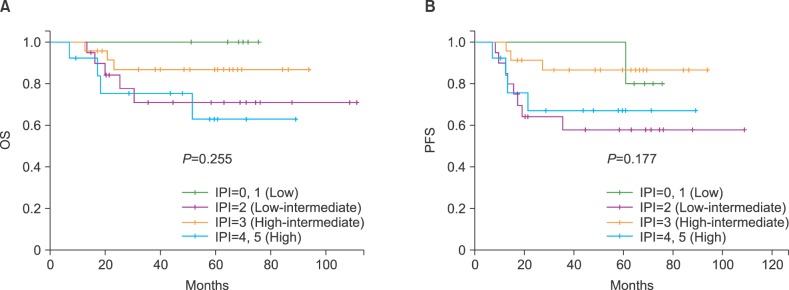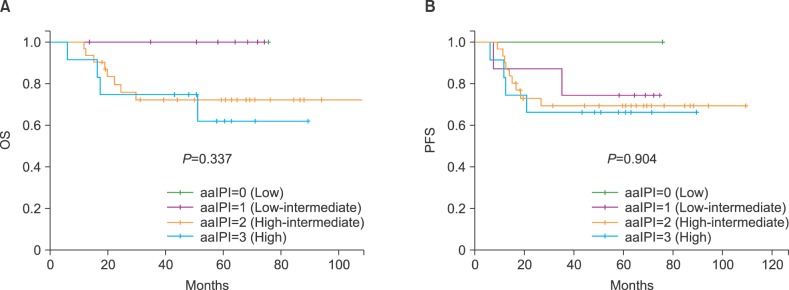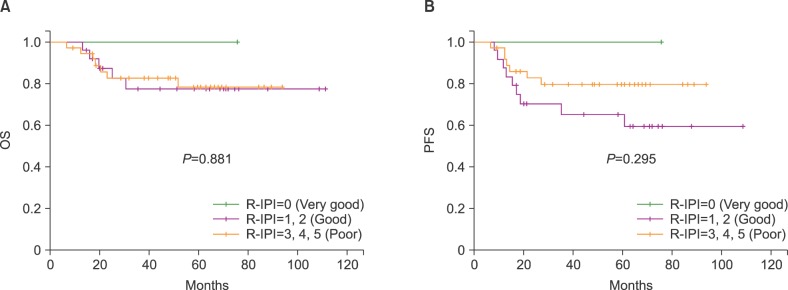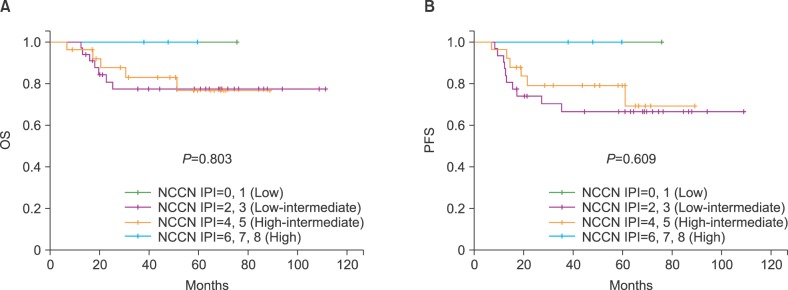Blood Res.
2015 Sep;50(3):160-166. 10.5045/br.2015.50.3.160.
Prediction of survival by applying current prognostic models in diffuse large B-cell lymphoma treated with R-CHOP followed by autologous transplantation
- Affiliations
-
- 1Department of Internal Medicine, Konkuk University Medical Center, Seoul, Korea. mlee@kuh.ac.kr
- 2Department of Internal Medicine, Seoul National University Hospital, Seoul, Korea.
- 3Department of Internal Medicine, Chonnam National University Hwasun Hospital, Hwasun, Korea.
- 4Department of Internal Medicine, The Catholic University of Korea College of Medicine, Suwon, Korea.
- 5Department of Internal Medicine, Kosin University Gospel Hospital, Busan, Korea.
- 6Department of Internal Medicine, Gachon University Gil Hospital, Incheon, Korea.
- 7Department of Internal Medicine, Samsung Medical Center, Seoul, Korea.
- 8Department of Internal Medicine, Wonkwang University School of Medicine, Iksan, Korea.
- 9Department of Internal Medicine, National Cancer Center, Goyang, Korea.
- 10Department of Internal Medicine, Hanyang University College of Medicine, Seoul, Korea.
- 11Department of Internal Medicine, Daegu Fatima Hospital, Daegu, Korea.
- 12Department of Internal Medicine, Soonchunhyang University Hospital, Bucheon, Korea.
- 13Department of Internal Medicine, Yonsei University College of Medicine, Seoul, Korea.
- 14Department of Internal Medicine, Dankook University Hospital, Cheonan, Korea.
- KMID: 2172759
- DOI: http://doi.org/10.5045/br.2015.50.3.160
Abstract
- BACKGROUND
Among the currently available prognostic models for diffuse large B-cell lymphoma (DLBCL), we investigated to determine which is most adoptable for DLBCL patients treated with rituximab, cyclophosphamide, doxorubicin, vincristine, and prednisone (R-CHOP) followed by upfront autologous stem cell transplantation (auto-SCT).
METHODS
We retrospectively evaluated survival differences among risk groups based on the International Prognostic Index (IPI), the age-adjusted IPI (aaIPI), the revised IPI (R-IPI), and the National Comprehensive Cancer Network IPI (NCCN-IPI) at diagnosis in 63 CD20-positive DLBCL patients treated with R-CHOP followed by upfront auto-SCT.
RESULTS
At the time of auto-SCT, 74.6% and 25.4% of patients had achieved complete remission and partial remission after R-CHOP, respectively. As a whole, the 5-year overall (OS) and progression-free survival (PFS) rates were 78.8% and 74.2%, respectively. The 5-year OS and PFS rates according to the IPI, aaIPI, R-IPI, and NCCN-IPI did not significantly differ among the risk groups for each prognostic model (P-values for OS: 0.255, 0.337, 0.881, and 0.803, respectively; P-values for PFS: 0.177, 0.904, 0.295, and 0.609, respectively).
CONCLUSION
There was no ideal prognostic model among those currently available for CD20-positive DLBCL patients treated with R-CHOP followed by upfront auto-SCT.
Keyword
MeSH Terms
Figure
Reference
-
1. A predictive model for aggressive non-Hodgkin's lymphoma The International Non-Hodgkin's Lymphoma Prognostic Factors Project. N Engl J Med. 1993; 329:987–994. PMID: 8141877.2. Sehn LH, Berry B, Chhanabhai M, et al. The revised International Prognostic Index (R-IPI) is a better predictor of outcome than the standard IPI for patients with diffuse large B-cell lymphoma treated with R-CHOP. Blood. 2007; 109:1857–1861. PMID: 17105812.
Article3. Zhou Z, Sehn LH, Rademaker AW, et al. An enhanced International Prognostic Index (NCCN-IPI) for patients with diffuse large B-cell lymphoma treated in the rituximab era. Blood. 2014; 123:837–842. PMID: 24264230.
Article4. Lee HG, Choi Y, Kim SY, et al. R-CHOP chemoimmunotherapy followed by autologous transplantation for the treatment of diffuse large B-cell lymphoma. Blood Res. 2014; 49:107–114. PMID: 25025012.
Article5. Cheson BD, Pfistner B, Juweid ME, et al. Revised response criteria for malignant lymphoma. J Clin Oncol. 2007; 25:579–586. PMID: 17242396.6. Le Gouill S, Milpied NJ, Lamy T, et al. First-line rituximab (R) high-dose therapy (R-HDT) versus R-CHOP14 for young adults with diffuse large B-cell lymphoma: Preliminary results of the GOELAMS 075 prospective multicenter randomized trial. J Clin Oncol. 2011; 29(Suppl):abst 8003.
Article7. Schmitz N, Nickelsen M, Ziepert M, et al. Conventional chemotherapy (CHOEP-14) with rituximab or high-dose chemotherapy (MegaCHOEP) with rituximab for young, high-risk patients with aggressive B-cell lymphoma: an open-label, randomised, phase 3 trial (DSHNHL 2002-1). Lancet Oncol. 2012; 13:1250–1259. PMID: 23168367.
Article8. Stiff PJ, Unger JM, Cook JR, et al. Autologous transplantation as consolidation for aggressive non-Hodgkin's lymphoma. N Engl J Med. 2013; 369:1681–1690. PMID: 24171516.
Article9. Vitolo U, Chiappella A, Brusamolino E, et al. Rituximab dose-dense chemotherapy followed by intensified high-dose chemotherapy and autologous stem cell transplantation (HDC+ASCT) significantly reduces the risk of progression compared to standard rituximab dose-dense chemotherapy as first line treatment in young patients with high-risk (aa-IPI 2-3) diffuse large B-cell lymphoma (DLBCL): Final results of phase III randomized trial DLCL04 of the Fondazione Italiana Linfomi (FIL). Blood. 2012; 120(Suppl):abst 688.
Article10. Ziepert M, Hasenclever D, Kuhnt E, et al. Standard International prognostic index remains a valid predictor of outcome for patients with aggressive CD20+ B-cell lymphoma in the rituximab era. J Clin Oncol. 2010; 28:2373–2380. PMID: 20385988.11. Inano S, Iwasaki M, Iwamoto Y, et al. Impact of high-dose chemotherapy and autologous transplantation as first-line therapy on the survival of high-risk diffuse large B cell lymphoma patients: a single-center study in Japan. Int J Hematol. 2014; 99:162–168. PMID: 24338743.
Article12. Gisselbrecht C, Schmitz N, Mounier N, et al. Rituximab maintenance therapy after autologous stem-cell transplantation in patients with relapsed CD20(+) diffuse large B-cell lymphoma: final analysis of the collaborative trial in relapsed aggressive lymphoma. J Clin Oncol. 2012; 30:4462–4469. PMID: 23091101.
Article13. Fitoussi O, Belhadj K, Mounier N, et al. Survival impact of rituximab combined with ACVBP and upfront consolidation autotransplantation in high-risk diffuse large B-cell lymphoma for GELA. Haematologica. 2011; 96:1136–1143. PMID: 21546499.
Article14. Takasaki H, Hashimoto C, Fujita A, et al. Upfront autologous stem cell transplantation for untreated high-risk diffuse large B-cell lymphoma in patients up to 60 years of age. Clin Lymphoma Myeloma Leuk. 2013; 13:404–409. PMID: 23763919.
Article
- Full Text Links
- Actions
-
Cited
- CITED
-
- Close
- Share
- Similar articles
-
- A Case of Mantle Cell Lymphoma Treated with Autologous Stem Cell Transplantation and Rituximab
- Autologous stem cell transplantation for diffuse large B-cell lymphoma with residual extranodal involvement
- Prognostic Significance of Neutrophil Lymphocyte Ratio and Platelet Lymphocyte Ratio in Diffuse Large B-Cell Lymphoma Patients Treated with R-CHOP
- R-CHOP chemoimmunotherapy followed by autologous transplantation for the treatment of diffuse large B-cell lymphoma
- Treatment results of radiotherapy following CHOP or R-CHOP in limited-stage head-and-neck diffuse large B-cell lymphoma: a single institutional experience





